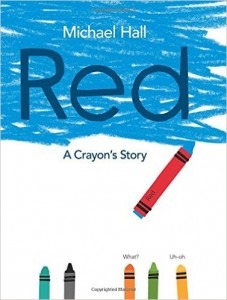Cameray and
The Burnaby Early Childhood Development Table
Book of the Month: Red: A Crayon’s Story
Red: A Crayon’s Story is an insightful story by Michael Hall. It’s about a red crayon that can only colour in blue. Other crayons ask the red crayon to help them with drawing strawberries, cherries, and other red things, but they all turn out blue. The red crayon feels a sort of identity crisis because as much as it tries, its intentions don’t match its outputs. That is, until the end of the story, when a berry coloured crayon asks the red crayon to draw a blue ocean. By the end, the red crayon realizes and accepts it can be itself, and that’s perfectly okay.
How can parents use this book?
This book has a simple but important message, while still being framed as a friendly read. Parents will probably have multiple interpretations of this book. One of which is that kids, like most people, feel better about themselves when they accept who they are, instead of trying hard to meet others’ expectations or conform to the way others think they should be. This is a very powerful message that can be delivered any way you see fit. Maybe you could read the book to your child, and then ask them what they think the story might be talking about if the red crayon were you, instead of just a crayon. This could be done after the book is done, or somewhere in the middle. For example, when the teacher thinks the red crayon just needs more practice. How might your child react if a teacher told them they just need more practice to get something right? Sometimes we aren’t able to be flawless even if we try, and that’s perfectly normal.
Some examples:
– If the red crayon was a person, what were the other crayons (or people) asking it to do? (They were trying to get the person to be someone they are not.)
– If the red crayon (person) decided to be themselves from the beginning, how might they feel? (They might not worry so much about losing their identity in the name of pleasing others.)
Parents could also talk to their child about differences. For example, how are your friends different from you? Do they expect you to act certain ways sometimes? Do you ever expect them to act certain ways? And how does that make them, or you, feel? Differences can be seen as a source of strength rather than weakness, as they bring people together. The moral of this story is very common one in children’s books: be yourself. But the way the message is presented is unique.
Check out the Burnaby ECD Table website for more book recommendations and great resources for parents with children under 6!

